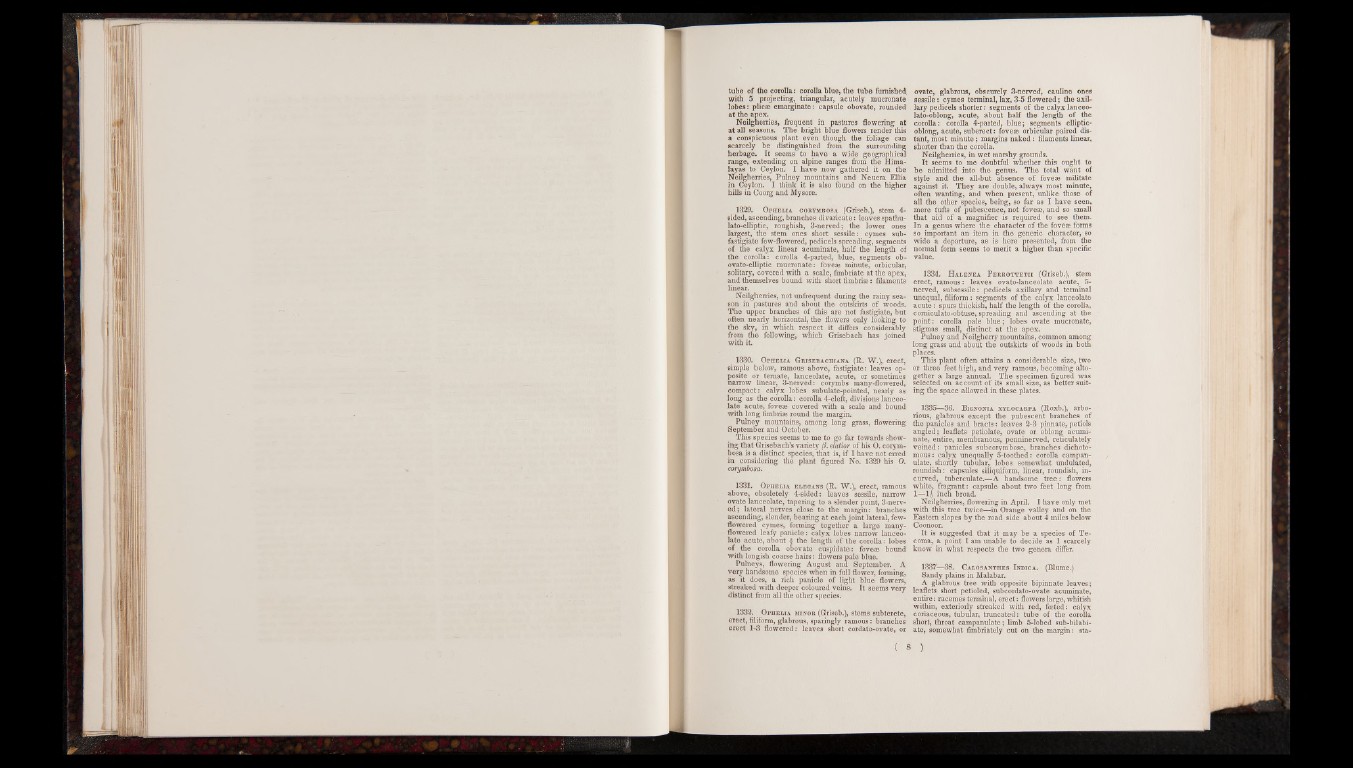
tube of the corolla: corolla blue, the tube furnished,
with 5 projecting, triangular, acutely mucronate
lobes: plicae emarginate: capsule obovate, rounded
at the apex.
Neilgherries, frequent in pastures flowering at
at all seasons. The bright blue flowers render this
a conspicuous plant even though the foliage can
scarcely be distinguished from the surrounding
herbage. It seems to have a wide geographical
range, extending on alpine ranges from the Himalayas
to Ceylon. I have now gathered it on the
Neilgherries, Pulney mountains and Neuera Ellia
in Ceylon. I think it is also found on the higher
hills in Coorg and Mysore.
1329. Ophelia cortmbosa (Griseb.), stem 4-
sided, ascending, branches divaricate: leavesspathu-
lato-elliptic, roughish, 3-nerved; the lower ones
largest, the stem ones short sessile: cymes sub-
fastigiate few-flowered, pedicels spreading, segments
of the calyx linear acuminate, half the length of
the corolla: corolla 4-parted, blue, segments ob-
ovato-elliptic mucronate: foveae minute, orbicular,
solitary, covered with a scale, fimbriate at the apex,
and themselves bound with short fimbriae: filaments
linear.
Neilgherries, not unfrequent during the rainy season
in pastures and about the outskirts of woods.
The upper branches of this are not fastigiate, but
often nearly horizontal, the flowers only looking to
the sky, in which respect it differs considerably
from the following, which Grisebach has joined
with i t
1330. Ophelia Grisebachiana (R. W.), erect,
simple below, ramous above, fastigiate: leaves opposite
or temate, lanceolate, acute, or sometimes
narrow linear, 3-nerved: corymbs many-flowered,
compact: calyx lobes subulate-pointed, nearly as
long as the corolla: corolla 4-cleft, divisions lanceolate
acute, foveae covered with a scale and bound
with long fimbriae round the margin.
Pulney mountains, among long grass, flowering
September and October.
This species seems to me to go far towards showing
that Grisebach’s variety (9. elatior of his O. corym-
bosa is a distinct species, that is, if I have not erred
in considering the plant figured No. 1329 his O.
corymbosa.
1331. Ophelia elegans (R. W.), erect, ramous
above, obsoletely 4-sided: leaves sessile, narrow
ovate lanceolate, tapering to a slender point, 3-nerved;
lateral nerves close to the margin: branches
ascending, slender, bearing at each joint lateral, few-
flowered cymes, forming together a large many-
flowered leafy panicle: calyx lobes narrow lanceolate
acute, about § the length of the corolla: lobes
o f the corolla obovate cuspidate: foveas bound
with longish coarse hairs: flowers pale blue.
Pulneys, flowering August and September. A
very handsome species when in full flower, forming,
as it does, a rich panicle of light blue flowers,
streaked with deeper coloured veins. It seems very
distinct from all the other species.
1332. Ophelia minor (Griseb.), stems subterete,
erect, filiform, glabrous, sparingly ramous: branches
erect 1-3 flowered: leaves snort cordato-ovate, or
ovate, glabrous, obscurely 3-nerved, cauline ones
sessile: cymes terminal, lax, 3-5 flowered; the axillary
pedicels shorter: segments of the calyx lanceo-
lato-oblong, acute, about half the length of the
corolla: corolla 4-parted, blue; segments elliptic-
oblong, acute, suberect: foveas orbicular paired distant,
most minute; margins naked: filaments linear,
shorter than the corolla.
Neilgherries, in wet marshy grounds.
It seems to me doubtful whether this ought to
be admitted into the genus. The total want of
style and the all-but absence of foveas militate
against it. They are double, always most minute,
often wanting, and when present, unlike those of
all the other species, being, so far as I have seen,
mere tufts of pubescence, not foveas, and so small
that aid of a magnifier is required to see them.
In a genus where the character of the foveas forms
so important an item in the generic character, so
wide a departure, as is here presented, from the
normal form seems to merit a higher than specific
value.
1334. Halenea P errottetii (Griseb.), stem
erect, ramous: leaves ovato-lanceolate acute, 5-
nerved, subsessile: pedicels axillary and terminal
unequal, filiform: segments of the calyx lanceolate
acute: spurs thickish, half the length of the corolla,
comiculato-obtuse, spreading and ascending at the
point: corolla pale blue; lobes ovate mucronate,
stigmas small, distinct at the apex.
Pulney and Neilgherry mountains, common among
long grass and about the outskirts of woods in both
places.
This plant often attains a considerable size, two
or three feet high, and very ramous, becoming altogether
a large annual. The specimen figured was
selected on account of its small size, as better suiting
the space allowed in these plates.
1335—36. Bignonia xylocarpa (Roxb.), arbo-
rious, glabrous except the pubescent branches of
the panicles and bracts: leaves 2-3 pinnate, petiols
angled; leaflets petiolate, ovate or oblong acuminate,
entire, membranous, penninerved, reticulately
veined: panicles subcorymbose, branches dichotomous:
calyx unequally 5-toothed: corolla campan-
ulate, shortly tubular, lobes somewhat undulated,
roundish: capsules siliquiform, linear, roundish, incurved,
tuberculate.—A handsome tree: flowers
white, fragrant: capsule about two feet long from
1—1£ inch broad.
Neilgherries, flowering in April. I have only met
with this tree twice—in Orange valley and on the
Eastern slopes by the road side about 4 miles below
Coonoor.
It is suggested that it may be a species of Te-
coma, a point I am unable to decide as I scarcely
know in what respects the two genera differ.
1337—38. Calosanthes Indica. (Blume.)
Sandy plains in Malabar.
A glabrous tree with opposite bipinnate leaves;
leaflets short petioled, sub cordato-ovate acuminate,
entire: racemes terminal, erect: flowers large, whitish
within, exteriorly streaked with red, fosted: calyx
coriaceous, tubular, truncated: tube of the corolla
short, throat campanulate; limb 5-lobed sub-bilabiate,
somewhat fimbriately cut on the margin: sta